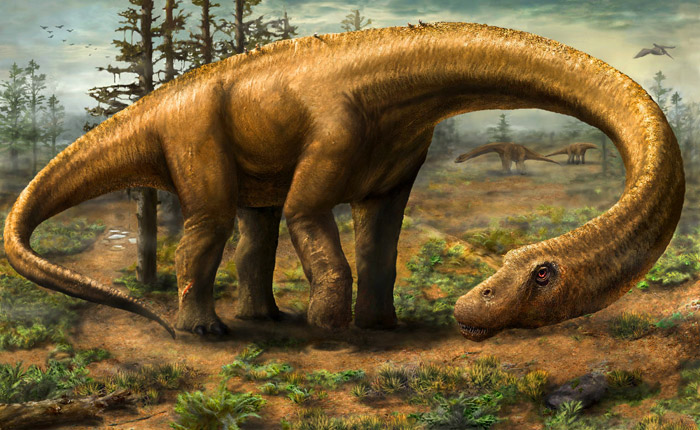Fear not:
The Dreadnoughtus
The dreadnought was a type of battleship developed in the 20th century that was known for its size and speed.
This massive ship is what inspired archeologists in Argentina when naming their most recent discovery—the Dreadnoughtus. Dreadnoughtus—member of the class Titanosauria, a group of dinosaurs named after the Titans of ancient Greece—is the largest land mammal to have ever existed. Titanosauria are massive herbivores “ranging from the weight of a cow to that of a sperm whale,” said Assistant Curator Matthew Lamanna, from the Carnegie Museum of Natural History. The Dreadnoughtus is not a regular garden-variety dinosaur. Its fossils, discovered and excavated in Argentina, were the largest and most complete Titanosaur fossils ever found. Scientists extrapolated from a 3D rendition that it probably weighed somewhere around 59,300 kilograms—heavier than a Boeing 747. In addition to its sheer physical size, it also possessed a ferocious tail to defend itself from predators. It is estimated that the Dreadnoughtus would require tens of thousands of calories each day in order to sustain itself—an impressive feat considering that its diet was exclusively plant-material.
Printable solar panels
The sun is always up in Australia. It should come as no surprise then that the University of Melbourne and Monash University, in collaboration with Australia’s National Science Agency, have developed printable solar panels that are almost ready for commercialization. According to Dr. Fiona Scholes, a senior scientist working on the project, the technology is inexpensive, and unlike traditional solar panels, can be made to be semi-transparent. The new technology functions as a ‘solar ink,’ as the panel is printed similarly to Canadian bills, and is just as flexible and lightweight. The end product contains panels of varying colours and appearances, and are lightweight and conformable while delivering a stable voltage under low light or indoors. From the glistening skyscrapers of packed cities to the harsh, arid environments of developing deserts, printable solar panels provide multifaceted and exciting possibilities.
Just think
The answer to the question, “If you could have one superpower, what would it be?” is oftentimes telepathy—a means of communication without using any of the five human senses. Incredibly, science fiction has been turned into reality, with the first documented case of telepathy confirmed this year. Two scientists—4,600 miles apart—telepathically sent the words ‘hola’ and ‘ciao’ to each other. The feat was accomplished over the course of several hours. Letters were converted into binaries, and were then fired as electric pulses to the occipital lobe of the recipient, who, blindfolded, saw white flashes in his peripheral vision. Eventually, the binary 0s and 1s are pieced together to form coherent words. Scientists claim that practical applications of this technology are still at least 20 years away. Nonetheless, further research in the field of brain-to-brain communication offers many possibilities.








